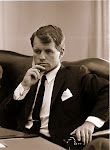| 1933 | March -- Before a crowd of 100,000 at the Capitol Plaza in Washington, D.C., Franklin Delano Roosevelt is inaugurated president. FDR tells the crowd, "The people of the United States have not failed. In their need they have registered a mandate that they want direct, vigorous action. They have asked for discipline and direction under leadership. They have made me the present instrument of their wishes. In the spirit of the gift I take it." FDR announces a four-day bank holiday to begin on Monday, March 6. During that time, FDR promised, Congress would work on coming up with a plan to save the failing banking industry. By March 9, Congress passed the Emergency Banking Act of 1933. By month's end, three-quarters of the nation's closed banks were back in business. On March 12, FDR delivers the first of what came to be known as his "fireside chats." In his initial "chat" he appealed to the nation to join him in "banishing fear." |
The Civilian Conservation Corps (CCC) is established. Designed as a relief and employment program for young men between the ages of 17 and 27, the CCC was envisioned by FDR as a kind of volunteer "army" that would work in national forests, parks, and federal land for nine-month stints. The first 250,000 young men were housed in 1,468 camps around the country. At its peak in 1935, the CCC would include 500,000 young men. | |
| May -- The Federal Emergency Relief Administration is created by Congress. President Franklin Roosevelt appointed Harry L. Hopkins as its chief administrator. By the end of his first day on the job, Hopkins had issued grants totaling more than $5 million. The National Industrial Recovery Act is introduced into Congress. Under Title I of the act, the National Recovery Administration was designated to maintain some form of price and wage controls. Section 7(a) of the act guaranteed labor the right to organize and bargain collectively. As part of the act, The National Labor Board was set up to negotiate disputes between labor and management. | |
| June -- Congress passes the Glass-Steagall act that separated commercial from investment banking and set up the Federal Deposit Insurance Corporation to guarantee bank deposits. | |
| September -- In an effort to stabilize prices, the federal agricultural program orders the slaughter of more than 6 million pigs. Many citizens protested this action since most of the meat went to waste. | |
| October -- The Civil Works Administration is established. Devised as a wide scale program that could employ up to 4 million people, the C.W.A was involved in the building of bridges, schools, hospitals, airports, parks and playgrounds. Additionally, C.W.A. funds went toward the repair and construction of highways and roads. Early in 1934, Congress authorized $950 million for the continued operation of the C.W.A. | |
| 1934 | |
| November -- Father Charles E. Coughlin establishes the Union for Social Justice. Using the radio airwaves as his pulpit, Father Coughlin railed against "predatory capitalism." His criticism of the banking industry and disdain of communism soon dovetailed into a troubling gospel of anti-Semitism. | |
| 1935 | April -- FDR signs legislation creating the Works Progress Administration. (Its name would be changed in 1939 to the Work Projects Administration). The program employed more than 8.5 million individuals in three thousand counties across the nation. These individuals, drawing a salary of only $41.57 a month, improved or created highways, roads, bridges, and airports. In addition, the WPA put thousands of artists -- writers, painters, theater directors, and sculptors -- to work on various projects. The WPA would remain in existence until 1943. "Business Week" magazine announces that "Depression is a forgotten word in the automobile industry, which is forging ahead in production, retail sales, and expansion of productive capacity in a manner reminiscent of the 'twenties.'" |
| June -- The National Youth Administration is set up to address the needs of young men and women (who were not allowed in the CCC). The NYA worked on two levels: a student work program and an out-of-school program. The student work program provided students with odd jobs that paid them enough to stay in school. The out-of-school program set young people up with various jobs ranging from house painting to cleaning local parks, and eventually came to include vocational training. | |
| July -- FDR signs the Wagner National Labor Relations Act. The goal of the act was to validate union authority and supervise union elections. | |
| August -- The Social Security Act of 1935 is signed into law by FDR. Among the most controversial stipulations of the act was that Social Security would be financed through a payroll tax. Historian Kenneth S. Davis called the signing of the act "one of the major turning points of American history. No longer could `rugged individualism' convincingly insist that government, though obliged to provide a climate favorable for the growth of business profits, had no responsibility whatever for the welfare of the human beings who did the work from which the profit was reaped." | |
2 years ago






No comments:
Post a Comment